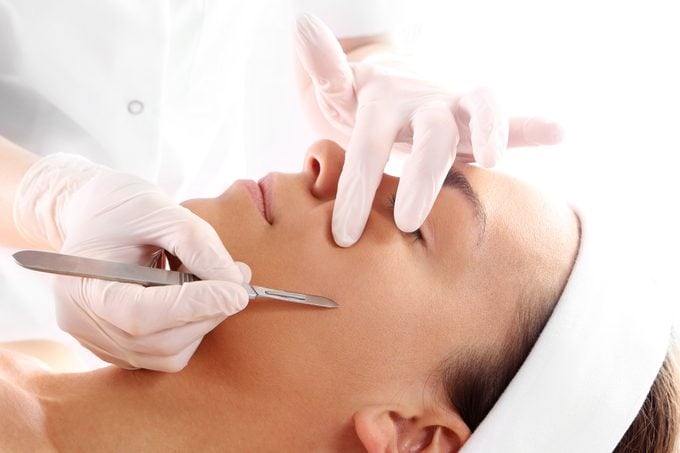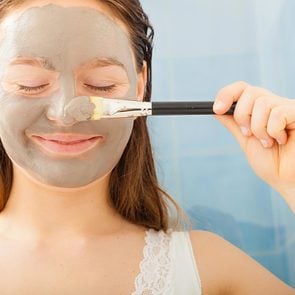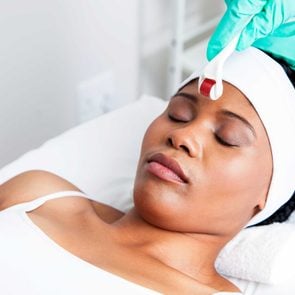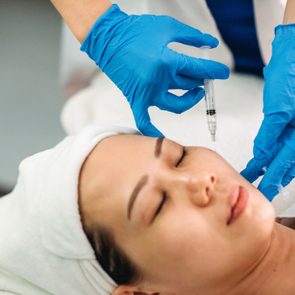Everything You Need to Know About Dermaplaning
Updated: Mar. 17, 2022
A dermaplaning treatment could do wonders for your skin. Here's what to know about the benefits of dermaplaning, as well as how to dermaplane at home.
Dermaplaning basics
It makes sense to look into skincare procedures before committing to a big purchase like laser hair removal or dermaplaning.
The next question is whether or not the treatment is worth the time and money it requires. If your goal is to exfoliate for glowing skin, dermaplaning might be a good idea.
Dermaplaning is a non-invasive skin treatment that involves using a razor blade to gently scrape away the “peach fuzz” facial hair as well as dead skin cells that build up at the skin’s surface.
How does dermaplaning work?

You can get this treatment from a dermatologist, says Stacy Chimento, MD, a board-certified dermatologist with Riverchase Dermatology in Miami.
First, the dermatologist cleanses the patient’s face and pats it dry. The next step involves making strokes across the surface of your skin with a scalpel or dermaplaning tool.
“You will feel the sensation of the blade on your skin, and it will feel similar to shaving with a razor,” Dr. Chimento says. “Your skin will not be pierced, and you will not feel any discomfort.”
To finish off the treatment, your dermatologist will apply a serum or moisturizer and sunscreen. The treatment typically takes no more than an hour.
Noelle Sherber, MD, a board-certified dermatologist in Washington, D.C., adds that dermaplaning is very much like shaving. It should not be painful or cause redness or irritation when performed properly.
“As with shaving body hair, women can expect to feel a slightly rough texture on the facial skin as hair grows back,” she says. “Women’s facial hair is more fine than body hair, so it will not feel like coarse stubble, but can be noticeable.”
(Does shaving make hair thicker?)
What are the benefits of dermaplaning?
Dermaplaning can help brighten a dull complexion by removing hair and dead skin cells at the surface, according to Deanne Mraz Robinson, MD, an assistant clinical professor of dermatology at Yale New Haven Hospital in Connecticut.
“Similar to other types of exfoliation, dermaplaning allows your skincare products to penetrate without interference,” she says. “So you may see an amplified plumping from your hyaluronic acid serum when you use it on freshly dermaplaned skin.”
People undergo a dermaplaning procedure when they are looking to make their skin appear more youthful, Dr. Chimento notes.
“Dermaplaning provides the benefits of removing wrinkles, fine lines, acne scars, and UV skin damage,” she says.
She adds that removing small hairs that hold oil and can clog pores helps people avoid acne, too.
Another perk is that makeup applies better on fuzz-free skin. In addition, this procedure is great for pregnant women who are searching for deep skin exfoliation, Dr. Chimento adds.
Still, there are some limitations to the benefits of this treatment, Dr. Sherber notes.
“Dermaplaning’s benefits as compared to other forms of manual exfoliation, such as facial scrubs, have not been well-studied,” she says. “Alpha hydroxy or beta hydroxy exfoliants can offer more benefits than simply removing dead skin cells, as they can also help to unclog pores, fade hyperpigmentation, and soften lines.”
It’s key to note that research on the benefits of this treatment is lacking. One review of 42 manuscripts in Aesthetic Plastic Surgery points out the overall scientific data supporting dermaplaning, among other non-invasive procedures, is scarce and anecdotal.
Yet the researchers note the therapies are increasingly popular because many patients and physicians or surgeons like their results.
Is dermaplaning safe?
Dermaplaning is relatively safe and well-tolerated by most skin types. And Dr. Chimento says dermaplaning is a great option for people with sensitive skin and those looking for a deep exfoliation.
Still, if you have inflamed acne, rosacea, eczema, psoriasis, or other active skin irritation, it would be wise to stay away from this procedure, Dr. Chimento and Dr. Robinson say. In these cases, it can have adverse effects and could cause long-term scarring or infection.
Otherwise, skin reddening may be present a few hours after the procedure, along with some whiteheads for a few days. As long as a board-certified dermatologist supervises, there aren’t many downsides to dermaplaning.
If the blade is not clean, there could also be a risk of infecting the skin or hair follicles with bacteria, according to Dr. Sherber.
As with anything, it’s key to understand the risks. This is especially true if you want to try dermaplaning at home.
“If you’re new to dermaplaning, I’d suggest trying it in a professional setting in tandem with a facial,” Dr. Robinson says. “In-office dermaplaning uses a very sharp, surgical-grade 10-blade scalpel in the hands of a trained professional.”
She says it’s the ideal way to experience the benefits of dermaplaning versus at-home devices and razors.
How to dermaplane
Yes, it’s possible to do it at home if you use the correct techniques and products.
“However, those who are dermaplaning themselves may have a hard time finding a scalpel with a rounded blade, and it is much easier to knick your skin if you are doing it yourself,” Dr. Chimento says. “I recommend seeing a professional to avoid harming the skin, and to receive the best results from the treatment.”
Dr. Robinson offers the following advice for people who feel like they want to try dermaplaning at home:
- Find a time when you can avoid applying makeup for 12 to 24 hours afterward.
- Wash your face well and dry it completely.
- Pull the skin taut and shave in the direction of the hair growth. This will minimize tugging on the hairs.
- Apply your skincare! “I like to use a chemical exfoliant for maximum exfoliation,” Dr. Robinson says. “It will tingle a bit! If your skin is sensitive or dehydrated, then go straight for your hyaluronic acid and antioxidant serums.”
- Sleep on a clean pillowcase with your hair tied back.
How do dermaplaning and microdermabrasion differ?
One common misconception is that dermaplaning and microdermabrasion are the same thing.
“Microdermabrasion provides skin aging benefits similar to dermaplaning, but is more aggressive in terms of exfoliation than dermaplaning,” Dr. Chimento says.
Microdermabrasion uses a spray of fine crystals or a diamond tip to sand or buff the skin’s surface, while dermaplaning uses a small single blade.
The former also creates abrasion and pressure with a vacuum and causes inflammation and pulling on the skin, while dermaplaning uses a gentle blade on dry skin to exfoliate, according to Dr. Chimento.
Next, check out these exfoliating mistakes to avoid.



